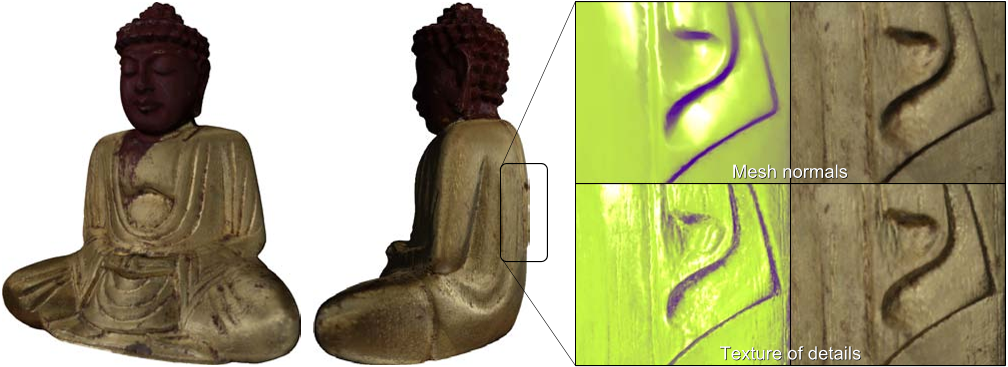




Did you find this useful? Give us your feedback



















24,320 citations
...Photometric stereo consists in computing high quality normal/range maps by taking several photographs from the same viewpoint but with different illumination directions [37]–[39], or by moving the object in front of a camera and a light source that are fixed with respect to each other [40], [41]....
[...]
...This is not a one-off fortuitous occurrence, but generally true (see additional examples at [37])....
[...]
...The figures for other values of d are at [37]....
[...]
...EXPERIMENTAL RESULTS We have designed all experiments such that they are reproducible, and as such, all data and code are freely available at [37]....
[...]
13,993 citations
...They differ from each other by the programming paradigm they use, ranging from scene-graph-based interfaces, like Scene.js [31] and GLGE [32], to procedural paradigms, like SpiderGL [33] and WebGLU [34]....
[...]
...do consider “Finding Motifs in a Database of Shapes” [34]....
[...]
...In 2007, Xi et al.[34] proposed a method to find image motifs or the most similar pair of images in the image database....
[...]
...js [31] and GLGE [32], to procedural paradigms, like SpiderGL [33] and WebGLU [34]....
[...]
6,938 citations
5,046 citations
...West: A Monograph of the British Desmidiaceae [32], which is still referenced in modern scientific texts, and some of them are vanity publications by “gentlemen scholars”....
[...]
...They differ from each other by the programming paradigm they use, ranging from scene-graph-based interfaces, like Scene.js [31] and GLGE [32], to procedural paradigms, like SpiderGL [33] and WebGLU [34]....
[...]
...js [31] and GLGE [32], to procedural paradigms, like SpiderGL [33] and WebGLU [34]....
[...]
...They are typical examples from the perhaps hundreds of books on Diatoms published during the Victorian era [23][28][32]....
[...]
4,107 citations
...Photometric stereo consists in computing high quality normal/range maps by taking several photographs from the same viewpoint but with different illumination directions [37]–[39], or by moving the object in front of a camera and a light source that are fixed with respect to each other [40], [41]....
[...]
Other appealing directions of work could include the possibility to enrich the Web publishing phase, by auto- matically formatting a Web page based not only on the 3D model, but on other types of data, like text and images.
Model data is saved under standard file formats: to store geometry information the authors use the Stanford polygon file format (PLY), which support multiple vertex attributes and binary encoding, while Portable Network Graphics (PNG) images are used for color and normal textures.
The most correct way to represent the material properties of an object is to describe them through a reflection function (e.g. BRDF), which attempts to model the observed scattering behavior of a class of real surfaces.
As expected, the projector illumination mask tends to increase the influence of image regions that correspond to the most illuminated surface parts, which leads to a conservation of luminosity.
due to the lack of consistency from one image to another, artifacts are visible at the junctions between surface areas receiving color from different images.
The diffuse color and detail textures recovery can take up to 5-10 minutes, while the data optimization for Web publishing is almost instantaneous.
The interaction metaphor known as world-in-hand or trackball has been used to facilitate the artifact inspection by using the mouse.
Since the complete geometric configura-tion of the scene is known, the authors can use a simple shadow mapping algorithm to estimate shadowed areas, to which a null weight is assigned.
thanks to the fact that the authors know the light position for each video frame, it is possible to partially recover them by using a photometric stereo approach.
Tens of high quality 3D models can be made available every day, for any kind of use (archival, study, presentation to the public).
During an acquisition, the only light source in the scene is the scanner projector itself, for which the position is always perfectly known.
Beside the developers fragmentation that arises due to this wide variety of available tools and to their incompatibilities, the burden incumbent upon the user for the installation of additional software components prevented a wide adoption of online 3D content.
Other appealing directions of work could include the possibility to enrich the Web publishing phase, by auto-matically formatting a Web page based not only on the 3D model, but on other types of data, like text and images.
Another issue, which is common to all the cited methods, is the projection of lighting artifacts on the model, i.e. shadows, highlights, and peculiar BRDF effects, since the lighting environment is usually not known in advance.
In order to correct (or to avoid to project) lighting artifacts, two possible approaches include the estimation of the lighting environment [23] or the use of easily controllable lighting setups [24].C. 3D graphics on the Web platformSince the birth of Internet, content of Web document has been characterized by several types of media, ranging from plain text to images, audio or video streams.
It has the property to save a significant amount of space for the vast majority of 3D models, for which, on average, a vertex is referenced by six triangles.
Even though the proposed approach is generic enough to be used in any application for which producing and sharing digital content about real artifacts present an interest, its three main advantages (namely its ease of use, its high automation and its quickness) make it particularly appropriate to cases where huge collections have to be processed.
To convey this advantage from memory occupancy to rendering performances, graphics accelerators have introduced a vertex cache capable of storing data associated to up to 32 vertices, thus allowing to reuse the results of a considerable amount of per-vertex calculations.